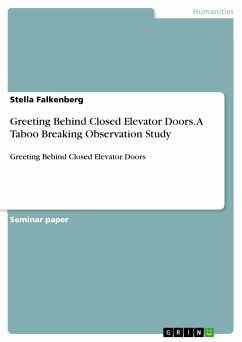
Greeting Behind Closed Elevator Doors. A Taboo Breaking Observation Study (eBook, PDF)
Greeting Behind Closed Elevator Doors
Sofort per Download lieferbar
Statt: 15,95 €**
13,99 €
inkl. MwSt. und vom Verlag festgesetzt.
**Preis der gedruckten Ausgabe (Broschiertes Buch)
Alle Infos zum eBook verschenkenWeitere Ausgaben:

PAYBACK Punkte
0 °P sammeln!
Seminar paper from the year 2018 in the subject Psychology - Social Psychology, grade: 1,3, University of Trier (Psychologie), course: Seminar Verhaltensbeobachtung, language: English, abstract: Often social sciences are concerned with the subject of civil inattention and the impact on passengers during elevator rides. Scientists have researched the non-verbal communication by observing how people react to rule breaking staring, or demonstrative avoidance of eye contact. Others researched about the basic rules of entering the elevator and the maximisation of distance inside the cabin in order ...
Seminar paper from the year 2018 in the subject Psychology - Social Psychology, grade: 1,3, University of Trier (Psychologie), course: Seminar Verhaltensbeobachtung, language: English, abstract: Often social sciences are concerned with the subject of civil inattention and the impact on passengers during elevator rides. Scientists have researched the non-verbal communication by observing how people react to rule breaking staring, or demonstrative avoidance of eye contact. Others researched about the basic rules of entering the elevator and the maximisation of distance inside the cabin in order to avoid personal contact. This is coupled with research on the space requirements of looks and the captive audience of conversations with other passengers. Recent studies about elevator design and its impact on the passengers showed that there are hierarchical systems inside elevators of office buildings when searching for the right position to protect personal space inside the cabin, the interaction of the passengers, as well as fixed rules for inconspicuous behaviour. According to Hirschauer (2005), the role of the elevator door "Talks are often opened and closed with the door" and in addition to studies about non-verbal conversation, an innovative survey was realized. How do elevator passengers react when they are confronted with a common yet unexpected greeting behind closed elevator doors after already having taken their personal inconspicuous position in the cabin? Is it more important to stay "invisible" than to be polite and to greet back? "...those people marked as present by the elevator, in most cases all agree to treat each other as not present." (Hirschauer, 2005) It is like breaking a taboo because in everyday situations the common greeting just happens while entering the elevator and not when the doors are already closed. Regarding the fact that the study was lanced in Germany it is important to remark that we cannot compare the greeting habits here to them in other nations. In the following the method of the observation is explained and the results are analysed.
Dieser Download kann aus rechtlichen Gründen nur mit Rechnungsadresse in A, B, BG, CY, CZ, D, DK, EW, E, FIN, F, GR, HR, H, IRL, I, LT, L, LR, M, NL, PL, P, R, S, SLO, SK ausgeliefert werden.













